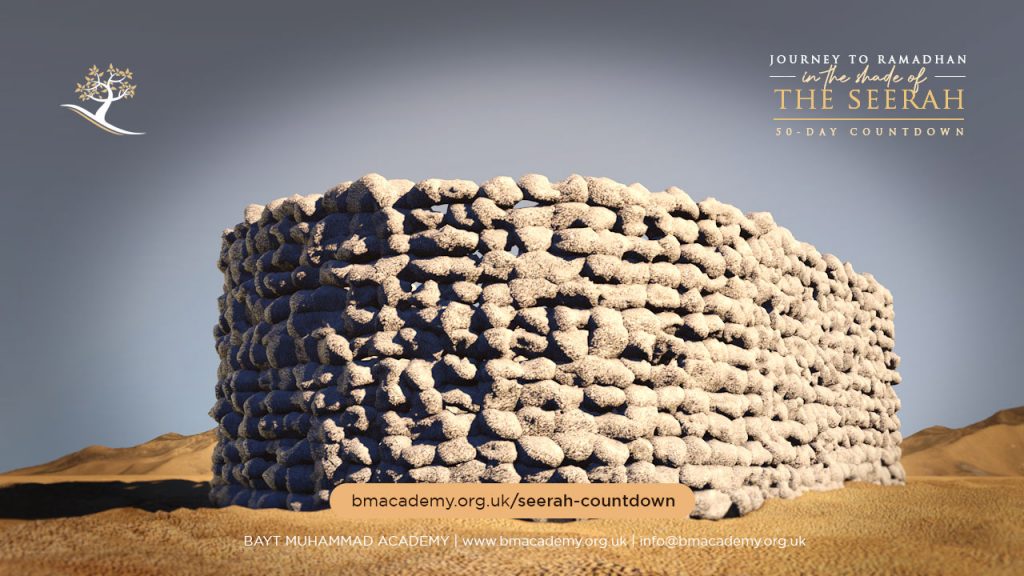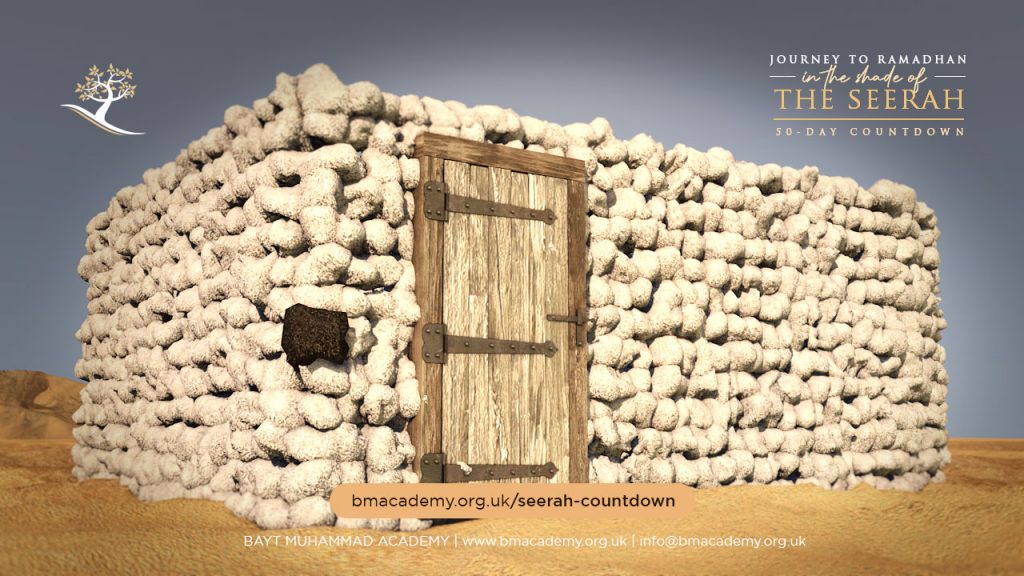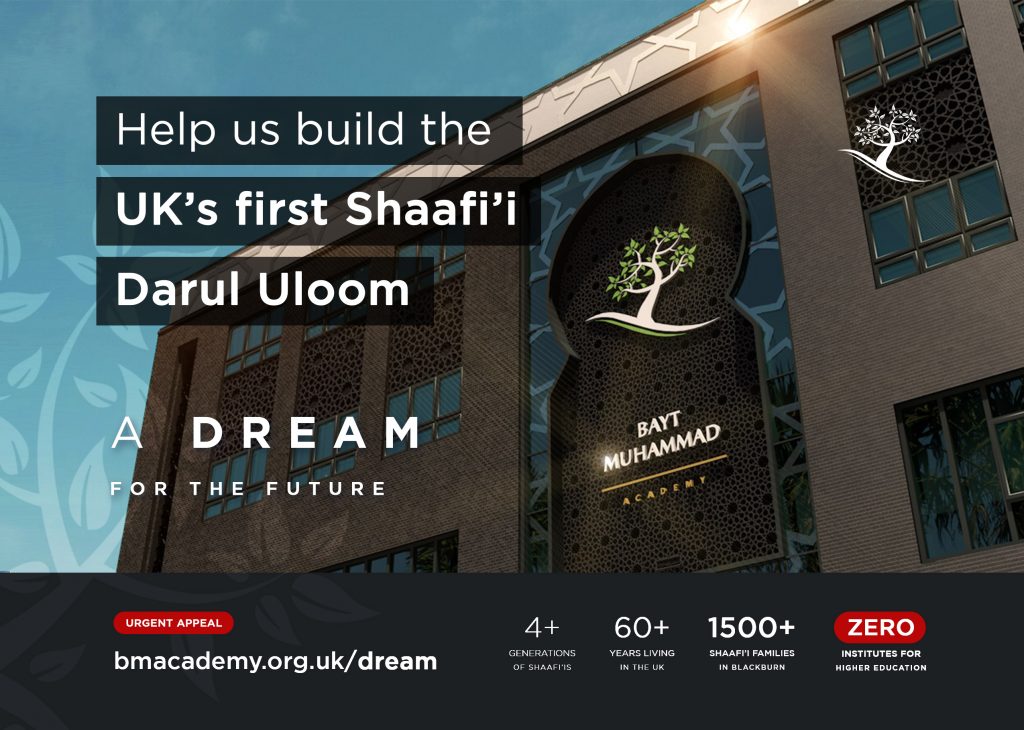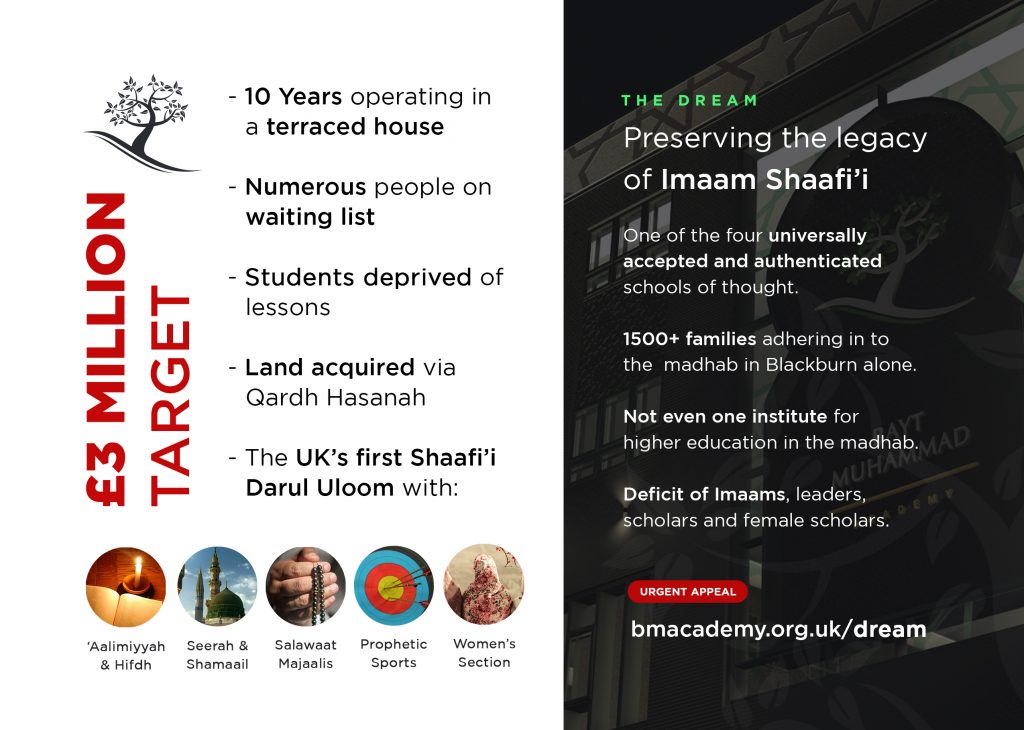بِسْمِ اللّٰهِ الرَّحْمٰنِ الرَّحِيْم
اَلْحَمْدُ لِلّٰهِ رَبِّ الْعَالَمِيْنَ وَ الصَّلوٰةُ وَ السَّلَامُ عَلىٰ اَطْيَبِ خَلْقِ اللهِ نَسَبًا وَ حَسَبًا وَ صَهْرًا , سَيِّدِنَا مُحَمَّدٍ وَ عَلىٰ آلِهِ وَ صَحْبِهِ وَ بَارِكْ وَ سَلِّمْ
After the Prophet’s ﷺ blessed marriage to Sayyidah Khadijah رضی الله عنها, their blessed home had grown and developed as the years passed. It had now been ten years since, and the Prophet ﷺ was now thirty-five years old. . He walked through the streets of Makkah brightening its day with His beautiful smile which uplifted the hearts of all he passed, as a beacon of hope for the poor and oppressed, the socially rejected and the communally abandoned. The situation of Makkah had now become more concerning than ever for the Prophet ﷺ. His ﷺ pure heart was pained by the rampant practices of Shirk (Paganism) & Jaahiliyyah (Ignorance), as well as the prevalence of deceit and immorality that had swept throughout Makkah.
His ﷺ blessed heart was especially grieved when witnessing the condition of the Kaa’bah. This was the legacy of his forefather Sayyidinaa Ibraahim علیه السلام, a structure he was commanded to build for the remembrance of Allah سبحانه و تعالی and the establishment of Tawheed. Yet the Prophet ﷺ would now see it surrounded by over three-hundred and sixty idols with repulsive forms.
The Original Kaa’bah
At this point in time the Kaa’bah was still upon the foundations and construction of Sayyidinaa Ibraahim علیه السلام, the shape and form of which was different to the cubic structure we see today. The Hateem or Hijr (the open semi-circle in front of the Kaa’bah) was enclosed within its structure, and thus the shape was more rectangular with a semi-circular edge on one side. Its walls were made of layered stone and were not very high, being slightly above the average head-height. The roof of the Kaa’bah was open without any form of ceiling enclosure.
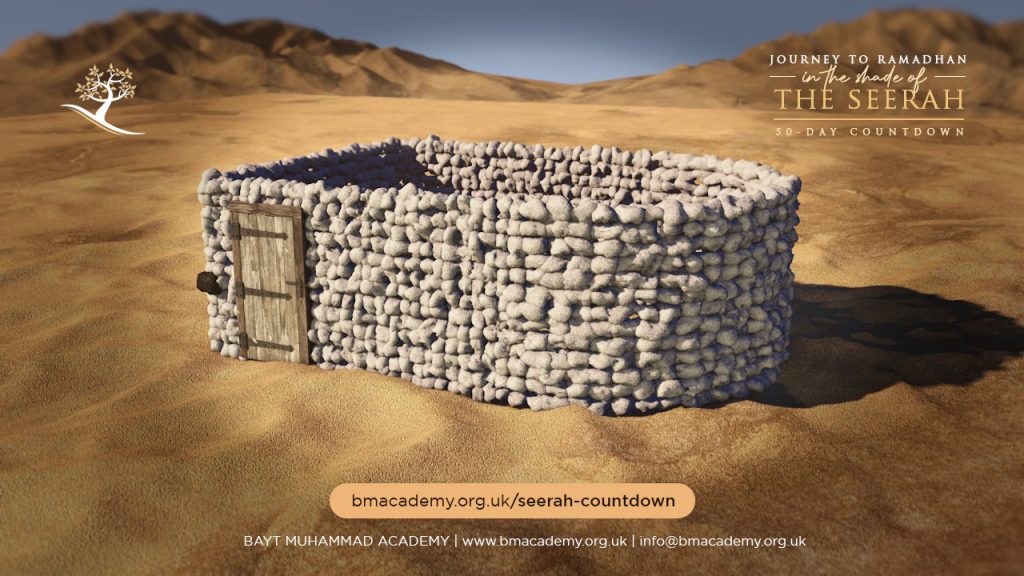
The Need for Renewal
In addition to the placement of idols, the structure of the Kaa’bah was also greatly neglected at this point. On one occasion a woman had heedlessly set fire to the Kiswah (The Outer Drapes of the Kaa’bah), through which the fire spread across its walls. Ignorance and greed had spread to the extent that thieves began seeing the lack of a roof as an opportunity to jump over its walls and steal any entrustments the Quraysh had placed within it. In addition to this, Makkah was affected by torrential flooding in this year, due to which the structure of the Kaa’bah – which was already in a state of disrepair – was irreversibly damaged.
After the effect of the flooding, the Kaa’bah was urgently in need of renovation. The leaders of Quraysh thus came to the realisation that they must now de-construct the current remains and build the Kaa’bah anew. Even though the people of Makkah and its elitist leaders had fallen into corrupt states, Allah سبحانه و تعالی preserved a special love and veneration for the Kaa’bah in their hearts. The decision to renovate was finalised and the preparatory discussions were underway.
The Planning Phase
The Quraysh began discussing the primary logistical factors for the project at hand, including funding, materials, structural engineering and the distribution of responsibilities. Concerns were raised in regards to various aspects, as the people of Makkah were not skilled in craftsmanship, nor did they have access to the required materials. Thereafter the matter of funding – which was perceived as the least concern – also became a major topic of concern, ultimately proving to be their biggest challenge in the end. However, they failed to realise… this was the plan of Allah سبحانه و تعالی, and to quote the words of the Prophet’s ﷺgrandfather Abdul-Muttalib:
ولهذا البيت رب هو يمنعه
“This house has a Lord, He will protect it!” (Ibn Ishaaq)
The next few events that transpired show us a glimpse of the detailed perfection and vast scale of Allah’s سبحانه و تعالی perfect decree for all things.
Pure for Pure
With the involvement of such wealthy and influential leaders, the matter of funding was considered the least of concern. However, their corrupt nature ensured that most – if not all – of their wealth was attained through illicit and immoral means, acquired unlawfully and oppressively. Would such sanctified walls be built upon such detestable foundations? Certainly not! Allah سبحانه و تعالی protected the sanctity of His house and placed it in the heart of Abu Wahab ibn Amr (the brother of the Faatimah bint ‘Amr, the Prophet’s ﷺ paternal grandmother), to take a stand and ensure that only pure wealth – gained through lawful and honourable means – would be utilised for this blessed project. Upon his statement, Allah سبحانه و تعالی endowed their hearts with a firm resolve to only bring forth the pure of their wealth.
With the matter of funding concluded, their remained the question of sourcing materials and finding a skilled-craftsmen for the structural engineering of the new Kaa’bah:
A Ship With a Purpose
From this moment onwards the books of Seerah give us a glimpse into the marvellous plan of Allah سبحانه و تعالی. He سبحانه و تعالی is the “Musabbibul Asbaab” (The Producer of Means). He سبحانه و تعالی is the one who brings forth grains from the depths of the earth and navigates them across oceans and shores, causing them to be held in the grasp of our plates for us to consume, little does man reflect! In the same amazing fashion, Allah سبحانه و تعالی caused a range of the finest materials to be gathered amidst a huge ship which would be dispatched for a construction project.
As we zoom out from the mountains of Makkah and into the gardens of Rome, a Byzantian king was loading a great ship of the finest building materials for the construction of a temple in Yemen. As this ship sets its course for Yemen, Allah سبحانه و تعالی sent a gale of wind and set the ship upon its true course: Jeddah. The ship thus washed up on the shores of the Jeddah port, the closest port to Makkah Al Mukarramah. Transition back into Makkah and we see that news of this ship reached the nobles of Quraysh, who immediately agreed upon its acquirement. When they reached the port to purchase all the materials, they were met with one more surprise: Baqoom, an extremely skilled craftsmen who was consigned to oversee construction alongside the materials on board.
Entering back into Makkah, we now find all the preparations underway and it was simply a matter of commencing the first phase of the project: Deconstruction.
The Audacity to Strike
The date was set and the greatest nobles of Quraysh gathered around the Kaa’bah to witness this ground-breaking event. There was only one problem: who dare have the audacity to strike any part of the Kaa’bah?
With all the great and mighty hands present, none had the strength to do so. After much commotion Al-Waleed ibn Al Mugheerah – one of the senior leaders of Quraysh – decided to initiate this blessed project and take the first step.
He reluctantly struck a portion of the wall between Rukn Al-Yamani (The Yemen-facing corner of the Kaa’bah) and Al-Hajar Al-Aswad. A great fear of punishment befell those who were present and they could not continue further. They decided to wait for a period and see what outcome befalls Al-Waleed ibn Mugheerah, citing him as a test of whether to proceed or not. The next-morning they found Al-Waleed safe and enthusiastically proceeding with demolishing the wall. Upon seeing him safe, others rushed to follow and the momentous project was initiated at his hands.
The Honour of Acceptance
An important point to reflect upon at this juncture is the matter of Al-Waleed ibn Mugheerah and his true nature. Whilst Al-Waleed ibn Mugheerah was accepted for the initiation of the project, this acceptance was of no avail to him in the end, for he possessed a corrupt heart and was devoid of the light of Imaan. He became one of the worst enemies to Our Prophet ﷺ and his mission, leading himself to the Hell-fire in the worst of manners. In short this is an eye-opening reality for all of us to ponder upon. True acceptance is not in our names being accepted, but rather in our deeds being accepted by Allah سبحانه و تعالی. The reality of good does not lie within our hands, but in our hearts.
Thus, when Sayyidinaa Ibraahim علیه السلام completed the huge task of constructing the Kaa’bah upon divine instruction, he did not dwell upon the privilege of being accepted for such a deed, but rather feared if the efforts produced at his hands were accepted by Allah سبحانه و تعالی. He supplicated to Allah سبحانه و تعالی upon completion saying:
وَإِذْ يَرْفَعُ إِبْرَٰهِـۧمُ الْقَوَاعِدَ مِنَ الْبَيْتِ وَإِسْمَـٰعِيلُ رَبَّنَا تَقَبَّلْ مِنَّآ ۖ إِنَّكَ أَنتَ السَّمِيعُ الْعَلِيمُ
“And [mention] when Ibraahim was raising the foundations of the House and [with him] Isma’eel, [saying], “Our Lord, accept [this] from us. Indeed, You are the Hearing, the Knowing” (Surah Al-Baqarah 2:127)
Thus, for all of us who have been accepted for the service of this religion, we must purify our intentions and seek that our efforts and actions be accepted by Allah سبحانه و تعالی. We must not concern ourselves with merely being accepted for such roles and titles.
Construction Commences
All of the walls at surface level were demolished and the Hajr Al Aswad was safely placed aside. They continued digging further, deep into the ground until they witnessed a layer of green cobalt stones that were merged in succession like camel humps. This was the original foundation placed by Sayyidinaa Ibraahim علیه السلام, firmly established in the ground through divine assistance. In the fervour of demolition, one of the Makkans rushed to dig beyond this foundation and barely completed striking between two stones when a huge tremor struck him, increasing in magnitude as it rippled throughout Makkah. This stopped them in their tracks and they knew not to touch this blessed foundation which was protected by Allah سبحانه و تعالی.
Under the supervision of Baqoom, the materials, roofing and framework were underway and the responsibility of construction was divided into the four sections of the Kaa’bah, with each section being assigned to a tribal faction of Quraysh.
In the footsteps of Sayyidinaa Isma’eel علیه السلام
As construction was on course, the Makkans worked throughout the day to complete the project. Our Beloved Prophet ﷺ personally contributed, working hard in the scorching heat of the sun. He took upon the same responsibility of his forefather Sayyidinaa Ismaa’eel علیه السلام, carrying the bricks which would build the walls of the blessed Kaa’bah.
Due to the severe heat and physical exertion, the people would dress in a single lower-garment in wrapped at waist-level. This left their shoulders and upper chest exposed to the grazing of the rough surfaces they carried. Our Prophet ﷺ was carrying the bricks with his paternal uncle Sayydinaa Abbas رضی الله عنه, when his uncle noticed the blessed shoulders of Our Prophet ﷺ being grazed. He رضی الله عنه advised that the lower-garment wrap be removed from the waist and placed over the shoulders to protect the skin. Many individuals had already done so without hesitation, even though this rendered them partially naked and exposed their private regions. The impact of Jahiliyyah had desensitised them from true Hayaa (Modesty) and normalised such a shameful act.
In such a society where nakedness was becoming normalised, the pure Hayaa of Our Prophet ﷺ was such that he barely removed his garment (upon the instruction of his uncle) when he ﷺ almost lost consciousness and immediately rushed to cover himself. This was the pure Fitrah (Nature) of Our Prophet ﷺ, even before prophethood. When a person loses such an integral part of their very essence, they repel the fabric of their nature and destroy an imperative branch upon which Imaan rests, as we know from the beautiful Hadith:
إِنَّ الْحَيَاءَ شُعْبَةٌ مِنَ الإِيمَانِ
“Indeed modesty is a branch of faith.” (Ibn Maajah)
Without this pillar of Hayaa, not only does one destroy themselves internally, but also prevents themselves from upholding Imaan, thus the Prophet ﷺ said:
إِذَا لَمْ تَسْتَحْيِ فَاصْنَعْ مَا شِئْتَ
“If you do not feel Hayaa (Modesty/Shame), then do whatever you like.” (Sahih Al-Bukhari)
Budget Constraints
Construction was reaching great progress, with an overwhelming majority of work nearing completion. It was at this moment that the Quraysh realised they were faced with severe budget constraints. The insufficient funds could not be replenished either, as all of the Halaal (lawfully acquired) wealth had already been depleted. Due to this obstacle and other contributing factors, an executive decision was made to alter the plans and reduce the final build of the Kaa’bah. This would result in the Kaa’bah being built 75% from one side, as they worked their way across the original foundation of Sayyidina Ibraahim علیه السلام, and then a wall being built to cap off the structure just before the Hateem (the semi-circle in front the Kaa’bah). The unconstructed area would then be fenced off with a trellis to mark the section where the walls originally would have been if construction was completed.
Hajr Al-Aswad: The Quest for Honour
As construction flowed steadily, they reached the phase of placing the blessed Hajr Al-Aswad (The Black Stone) back into its position. At this critical juncture, the question arose as to who would yield this honour?. Various notables and tribal leaders rushed to the opportunity, insisting they must acquire this prestigious task. The situation became intense as their insistence turned into persistence. Voices were raised and the debate intensified, with each person fighting for their tribe to be rightful. This led to a halt in construction and delayed progression for a number of days, until the fierce quarrels erupted and physical combat was imminent. Swords were drawn and bloodshed was in order for the attainment of this honour. Each fighting party determined to exclude the rest, so they alone could bear the pride of its imposition.
At this critical moment, Abu Umayyah ibn Mugheerah Al-Makhzoomi – one of the oldest and wisest men of Quraysh – called out in one final attempt of desperation. He wished to prevent the fighting by offering an alternative solution that everyone may find plausible. The people turned their attention towards him amidst this fierce, blood-rushing moment, awaiting his solution to this issue. But a wise man is called so for a reason. Abu Umayyah knew not to put himself in between this fierce cross-fire, as any solution would result in a number of excluded parties being infuriated and seeking vengeance upon the provider of the solution. Abu Umayyah however, proposed a different path. He advised that all the tribes focus their attention towards the entrance of the sacred precincts of the Haram, and whomsoever will be the first to enter may decide which tribe will be elected. The people agreed to this and quickly focussed their attention on who will enter.
All eyes were now set upon the entrance of the haram. Their blood was still rushing in infuriation, whilst their hearts began pumping rapidly in suspense. Each of them wondered whether the one who enters will favour them and exclude the others, or will the opposite be so? The sound of their racing-hearts began drowning out the rush of thoughts erupting in their minds, when suddenly the sound of footsteps emerging in the distance reached their ears. Intensity levels were raised to the maximum as and their sights were fixing in towards the entrance when suddenly…none other than Our Master Muhammad ﷺ graced the haram with his blessed presence.
A cheer of smiles and chants instantly erupted and echoed throughout the haram, as the spirits of one and all – including the Kaa’bah and the ground of the haram itself – were uplifted. Each of them chanting:
هَذَا الْأَمِينُ، رَضِينَا، هَذَا مُحَمَّدٌ
“This is Al-Ameen (The Trustworthy), We are pleased! This is Muhammad!” (Ibn Hisham)
This was the only soul that had never wronged a single person. Due to the beauty of his character, each person felt they were the dearest to him and he ﷺ would certainly favour them. This scene was completely sudden and unexpected for the Prophet ﷺ, who was surrounded by the rush of people. The issue was raised to the Prophet ﷺ amongst the bustle of voices calling out, each of them asking who should be chosen and who should be excluded. However, they could not see any other solution besides elimination and exclusion. But this was the heart of the Prophet ﷺ, they were asking. His heart would not exclude anyone from that which was good and beneficial. He would always strive to include everyone in matters of good.
When the Prophet ﷺ was born into this world, Iblees (The Arch-Devil) violently screamed out in despair, knowing he had lost to the one who would save more people from being excluded to the hell-fire, than all of the Prophets that came before him ﷺ (Al-Bidaayah Wa Al-Nihaayah)
The Prophet ﷺ instructed that a large sheet be brought, upon which the Hajr Al-Aswad will be placed. Thereafter every tribal representative will hold the edge of the sheet together – in unity – and manoeuvre the stone to its designated position. Finally, the Prophet ﷺ fixed it into its place as the cloth was removed.
Thus, the Prophet ﷺ – as a young man of thirty-five – displayed his immense wisdom and intellect, which not only provided an ingenious solution that removed the obstacle of construction for this blessed project, but also prevented a civil war in the blessed precincts of the haram.
A New Hope
After this, the construction flowed rapidly and the new Kaa’bah was built. The constructed portion was in the form a square and was approximately fifteen meters high. The Hajr Al-Aswad wall and its adjacent side were ten meters wide, whilst the remaining two sides were twelve meters wide. The Black Stone was positioned 1.5 meters above the ground. The door of the Kaa’bah was raised higher at two metres above ground level. A roof was constructed from Timber and held up by six internal pillars. (Ar-Raheeq Al-Makhtoom, Sahih Al-Bukhari, Ibn Hisham)
The renewal of the Kaa’bah was a momentous project which caused rejoice throughout Makkah. The context of its timing however, foreshadowed a much greater renewal: The renewal of the entire city of Makkah, and the whole world as we know it…
Join us tomorrow as we continue with our next article: “The Cave of Hira: The Prelude to Prophethood”
